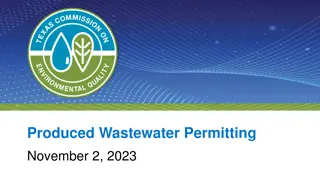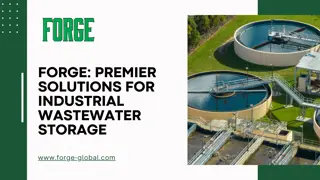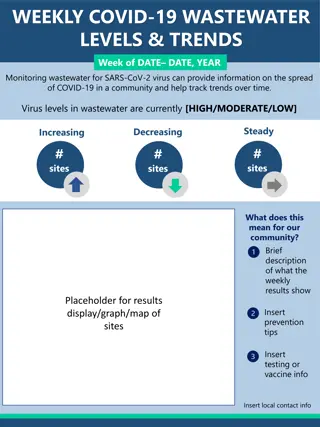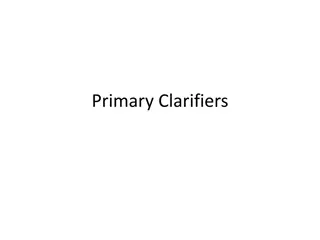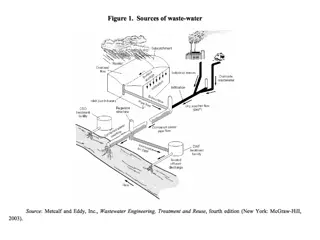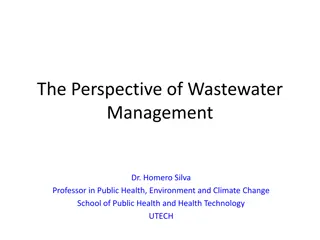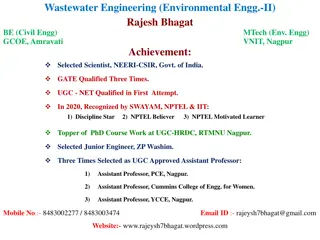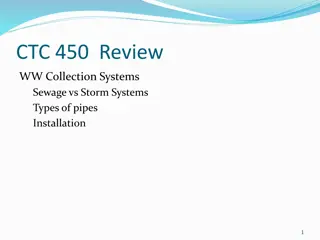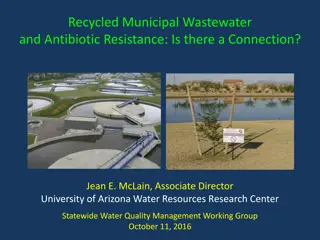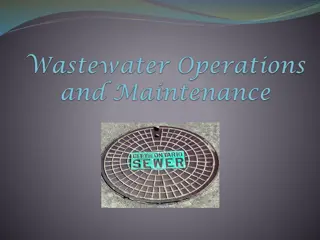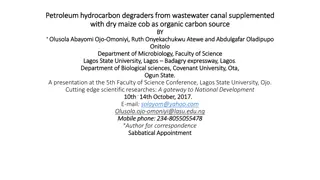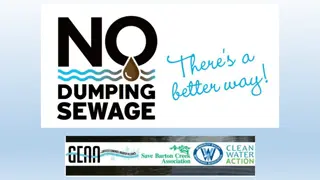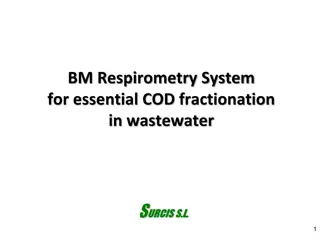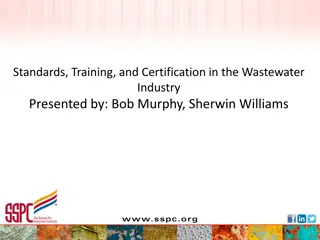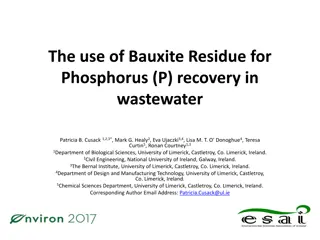Sustainable Solutions for Wastewater Management in India
India faces challenges in wastewater disposal, with underutilized sewage capacity and environmental concerns. Decentralized Waste Water Treatment Systems (DEWATS) offer a solution by providing reliable, long-lasting treatment for both domestic and industrial sources. DEWATS can help combat water pollution, meet discharge standards, and reduce wastewater pollution by up to 90%, offering sustainable benefits and resource recovery options.
Download Presentation

Please find below an Image/Link to download the presentation.
The content on the website is provided AS IS for your information and personal use only. It may not be sold, licensed, or shared on other websites without obtaining consent from the author. Download presentation by click this link. If you encounter any issues during the download, it is possible that the publisher has removed the file from their server.
E N D
Presentation Transcript
Subject: Infrastructure and Transport Planning Topic: Disposal Presented by: Aditi Arora
DISPOSAL INDIA SCENARIO India has installed treatment capacity to treat roughly 20 per cent of excreta generated. Delhi has 40% of India s installed sewage capacity. But 70% of sewage capacity installed in the city remains under-utilised. - SEPTIC TANK HOUSEHOLD - COMPOSTING - DISPOSAL TO SEWER - BURIAL DISPOSAL SYSTEMS EFFECTS IN INDIA - Land, - Volume, - Groundwater pollution, - Availability of open drains, - Permeability of the soil. - DUMPING ON LAND - SANITARY LANDFILL - COMPOSTING COMMUNITY - INCINERATION - REDUCTION AND SALVAGE
Decentralised Waste Water Treatment Systems Technology (DEWATS) DEWATS applications provide treatment for both domestic and industrial sources Systems can be designed to handle organic wastewater flows from 1-1000 m3 per day Systems are built to be reliable, long lasting and tolerant towards fluctuations in loads DEWATS applications do not require sophisticated maintenance In class I and II cities of India, a sewage treatment capacity of only 6,190 million litres per day (MLD) has been installed against the total sewage generation of 29,129 MLD . Therefore, promoting decentralised waste water treatment systems both at individual and institutional levels can offset this problem to a greater extent. DEWATS stands for Decentralized Wastewater Treatment Systems . DEWATS represents a technical approach rather than merely a technology package. Primary treatment: sedimentation and floatation Secondary anaerobic treatment in fixed-bed reactors: baffled upstream reactors or anaerobic filters Tertiary aerobic treatment in sub- surface flow filters Tertiary aerobic treatment in polishing ponds
Benefits of DEWATS Establishment of multi-stakeholder networks to combat water pollution Increases implementation capacity on various levels Provides treatment for both, domestic and industrial wastewater at affordable price Fulfillment of discharge standards and compliance with environmental laws Wastewater pollution reduction by up to 90% from pre-DEWATS levels. Provides treatment for wastewater flows up to 1000 m3 / day Reliable and long lasting applications Tolerant towards inflow and load fluctuation Materials/ inputs used for construction are locally available Minimal maintenance and long de-sludging intervals Low operation and maintenance costs Resource efficiency and non-dependence on energy Resource recovery through wastewater re-use and biogas generation
Pros and Cons of DEWATS Type Kind of Treatment Used for Type of Wastewater Advantages Disadvantages septic tank sedimentation, sludge stabilisation sedimentation, sludge stabilisation wastewater solids, especially domestic wastewater solids, especially domestic of settleable simple, durable, little space because of being underground simple, durable, little space because of being underground odourless effluent low treatment efficiency, effluent not odourless Imhoff tank of settleable less simple than septic tank, needs very regular desludging Anaerobic filter Anaerobic degradation of suspended dissolved solids pre-settled industrial narrow COD/BOD ratio domestic wastewater and of simple and fairly durable if well constructed and wastewater has been properly pre- treated, high treatment efficiency, little permanent space required because of being underground costly in construction because of special filter material, blockage of filter possible, effluent smells slightly despite high treatment efficiency and Baffled septic tank Anaerobic degradation of suspended dissolved solids pre-settled industrial narrow suitable for strong industrial wastewater domestic wastewater COD/BOD simple and fairly durable if well constructed and wastewater has been properly pre- treated, high treatment efficiency, little permanent space required because of being underground, hardly any blockage, relatively cheap compared to anaerobic filter The challenge and of ratio requires larger space for construction, less efficient with weak wastewater, longer start-up phase than anaerobic filter and
Horizontal gravel filter Aerobic anaerobic degradation dissolved and fine suspended pathogen removal facultative suitable for domestic and weak wastewater settleable solids and most suspended solids already removed by pre-treatment high treatment efficiency when properly constructed, pleasant landscaping possible, no wastewater above ground, can be cheap in construction if filter material is available at site, no nuisance of odour high permanent space requirement, costly if right quality of gravel is not available, great knowledge and care required during construction, intensive maintenance and supervision during first 1 2 years industrial where of solids, Anaerobic pond sedimentation, anaerobic degradation sludge stabilisation strong and medium industrial wastewater simple in construction, flexible in respect to degree of treatment, little maintenance wastewater pond occupies open land, there is always some odour, can even be stinky, mosquitoes are difficult to control and Aerobic pond Aerobic degradation, pathogen removal weak, mostly pre-treated wastewater from domestic and industrial sources simple performance if proper dimensioned, high pathogen removal rate, can be used to create an almost natural environment, fish farming possible when large in size and low loaded in construction, reliable in large permanent space requirement, mosquitoes and odour can become a nuisance if undersized, algae can raise effluent BOD Delhi statistics 1 Treated effluent supplied to CPWD for horticultural purposes in Luytens Delhi from Okhla STP Treated Effluent supplied to Pragati Power Plant from Dr Sen Nursing Home nala and Delhi gate Nala STPs Treated Effluent supplied to DDA for Japanese Park from Rithala STP Treated Effluent Supplied to Minor irrigation Deptt. from Okhla STP (42 cusec),from keshopur STP (37 cusec), and from Coronation STP(70 cusec); Total 149 cusec for irrigation purposes Total 20.0 MGD 2 4.0 MGD 3 8.0 MGD 4 80.5 MGD 109.5 MGD
GREY WATER DISPOSAL What is Grey water? Grey water is all wastewater that is discharged from a house, excluding black water (toilet water). This includes water from showers, bathtubs, sinks, kitchen, dishwashers, laundry tubs, and washing machines .It commonly contains soap, shampoo, toothpaste, food scraps, cooking oils, detergents and hair. Grey water makes up the largest proportion of the total wastewater flow from households in terms of volume. Typically, 50-80% of the household wastewater is grey water.
Most grey water ends up as effluent in rivers and oceans. There are other alternatives to eliminating greywater that allow for efficient use; using it to irrigate plants is a common practice. The plants use contaminants of greywater, such as food particles, as nutrients in their growth. However, salt and soap residues can be toxic to microbial and plant life alike, but can be absorbed and degraded through constructed wetlands and aquatic plants such as sedges, rushes, and grasses. GREY WATER RECYCLING - Most greywater should be recycled and collected using a separate plumbing system from black water. Domestic greywater can be recycled directly within the home, garden or company and used either immediately or processed and stored.
ECOLOGICAL BENEFITS OF GREYWATER RECYCLING Because greywater use, especially domestically, reduces demand on conventional water supplies and pressure on sewage treatment systems, its use is very beneficial to local waterways. In times of drought, especially in urban areas, greywater use in gardens or toilet systems helps to achieve some of the goals of ecologically sustainable development. The potential ecological benefits of greywater recycling include : Lower freshwater extraction from rivers and aquifers. Less impact from septic tank and treatment plant infrastructure. Topsoil nitrification. Reduced energy use and chemical pollution from treatment. Groundwater recharge. Increased plant growth. Reclamation of nutrients. Greater quality of surface and ground water when preserved by the natural purification in the top layers of soil than generated water treatment processes.
DLF GOLF COURSE AT GURGAON, NURTURED BY RECYCLED GREY WATER PRODUCED EVERYDAY BY DLF CITY



